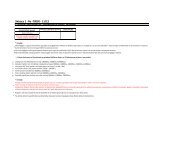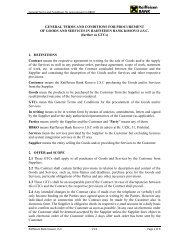Annual Report 2012 - Raiffeisen Bank Kosovo JSC
Annual Report 2012 - Raiffeisen Bank Kosovo JSC
Annual Report 2012 - Raiffeisen Bank Kosovo JSC
You also want an ePaper? Increase the reach of your titles
YUMPU automatically turns print PDFs into web optimized ePapers that Google loves.
a) Impairment charge for credit losses<br />
The <strong>Bank</strong> reviews its loan portfolios to assess impairment at least on a quarterly basis. In determining whether an<br />
impairment loss should be recorded in the profit or loss, the <strong>Bank</strong> makes judgments as to whether there is any observable<br />
data indicating that there is a measurable decrease in the estimated future cash flows from a portfolio of loans before<br />
the decrease can be identified with an individual loan in that portfolio. This evidence may include observable data<br />
indicating that there has been an adverse change in the payment status of borrowers in a <strong>Bank</strong>, or national or local<br />
economic conditions that correlate with defaults on assets in the <strong>Bank</strong>.<br />
Management uses estimates based on historical loss experience for assets with credit risk characteristics and objective<br />
evidence of impairment similar to those in the portfolio when scheduling its future cash flows. The methodology and<br />
assumptions used for estimating both the amount and timing of future cash flows are reviewed regularly to reduce any<br />
differences between loss estimates and actual loss experience.<br />
b) Impairment of available for-sale investments<br />
The <strong>Bank</strong> determines that available-for-sale investments are impaired when there has been a significant or prolonged<br />
decline in the fair value below its cost. This determination of what is significant or prolonged requires judgment.<br />
In making this judgment, the <strong>Bank</strong> evaluates among other factors, the normal volatility in share price. In addition,<br />
impairment may be appropriate when there is evidence of deterioration in the financial health of the investee, industry<br />
and sector performance, changes in technology, and operational and financing cash flows.<br />
c) Impairment of foreclosed assets<br />
The process of calculating impairment loss requires that the management make significant and complex assumptions<br />
regarding the projected period of sale of foreclosed assets, their estimated net sales value and the corresponding<br />
discount rate, in order to discount to net present value the expected cash flow from sale of specific items of foreclosed<br />
properties.<br />
Management of the <strong>Bank</strong> believes that the foreclose assets will be sold in a reasonable time frame, with no loss.<br />
d) Recent volatility in global financial markets<br />
The unprecedented crisis in international financial markets, during <strong>2012</strong> and 2011, had some but limited impact in the<br />
financial sector in <strong>Kosovo</strong>, as there was no major exposure of the sector abroad. Any exposure in Securities was limited<br />
to OECD countries with AAA rating countries. <strong>Kosovo</strong> banking sector continued its normal operations by relying on<br />
lending to the domestic economy, while its main source of finance remained deposits in <strong>Kosovo</strong>.<br />
4. Financial risk management<br />
4.1 Overview<br />
The <strong>Bank</strong> has exposure to the following risks from its use of financial instruments:<br />
<br />
<br />
<br />
<br />
This note presents information about the <strong>Bank</strong>’s exposure to each of the above risks, the <strong>Bank</strong>’s objectives, policies and<br />
processes for measuring and managing risk, and the <strong>Bank</strong>’s management of capital.<br />
Risk management framework<br />
The internal controls and additional risk control tools set by <strong>Raiffeisen</strong> International Risk Management enable the<br />
controlled risk management of the overall <strong>Bank</strong>. The risk management and risk control tools have been set according to<br />
the latest risk management know-how. The main Risk Management Tools have been endorsed by <strong>Raiffeisen</strong> International<br />
and are applied for use by the <strong>Bank</strong>.<br />
<br />
covering credit and market risks. The standardised approach is being applied so far. Its transformation into the latest<br />
approach is in the development phase. The implementation of Basel II requirements should ensure a better management<br />
of the capital.<br />
43<br />
Addresses Glossary Financial Statements Segment <strong>Report</strong>s Overview Macroeconomic Environment RBI Vision and Mission Management Board Introduction

















